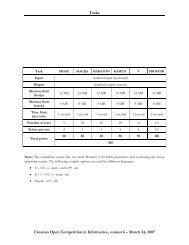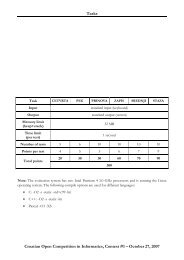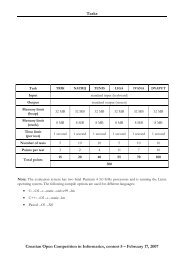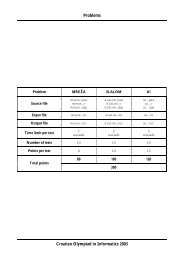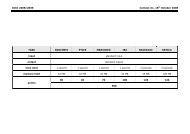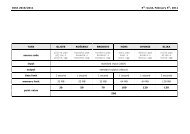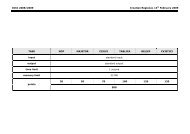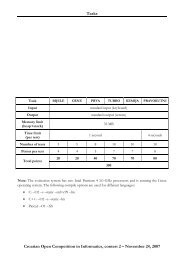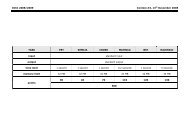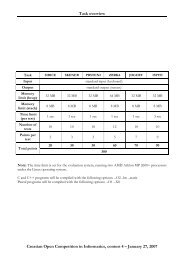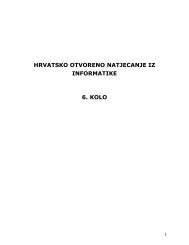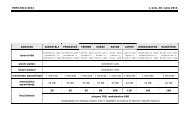You also want an ePaper? Increase the reach of your titles
YUMPU automatically turns print PDFs into web optimized ePapers that Google loves.
Task overview<br />
Task MODULO HERMAN OKVIRI SLIKAR BOND DEBUG<br />
Input<br />
Output<br />
Memory<br />
limit (heap)<br />
Memory<br />
limit (stack)<br />
Time limit<br />
(per test)<br />
Number of<br />
tests<br />
Points<br />
per test<br />
Total points<br />
standard input (keyboard)<br />
standard output (screen)<br />
32 MB 32 MB 32 MB 32 MB 32 MB 32 MB<br />
8 MB 8 MB 8 MB 8 MB 8 MB 8 MB<br />
1 sec 1 sec 1 sec 1 sec 1 sec 1 sec<br />
10 10 10 10 10 15<br />
1 2 3 5 7 8<br />
10 20 30 50 70 120<br />
300<br />
Note: The time limit is based on a computer running two AMD Athlon MP 2600+ processors and<br />
Linux operating system.<br />
C and C++ programs will be compiled with the following options: -O2 -lm.<br />
Pascal programs will be compiled with the following options: -So -O1 -XS.<br />
Croatian Open Competition in Informatics, Contest 1 – October 28, 2006
1. MODULO<br />
Given two integers A and B, A modulo B is the remainder when dividing A by B. For example, the<br />
numbers 7, 14, 27 and 38 become 1, 2, 0 and 2, modulo 3. Write a program that accepts 10 numbers<br />
as input and outputs the number of distinct numbers in the input, if the numbers are considered<br />
modulo 42.<br />
Input<br />
The input will contain 10 non-negative integers, each smaller than 1000, one per line.<br />
Output<br />
Output the number of distinct values when considered modulo 42 on a single line.<br />
Sample tests<br />
input<br />
1<br />
2<br />
3<br />
4<br />
5<br />
6<br />
7<br />
8<br />
9<br />
10<br />
output<br />
10<br />
input<br />
42<br />
84<br />
252<br />
420<br />
840<br />
126<br />
42<br />
84<br />
420<br />
126<br />
output<br />
1<br />
input<br />
39<br />
40<br />
41<br />
42<br />
43<br />
44<br />
82<br />
83<br />
84<br />
85<br />
output<br />
6<br />
Clarification:<br />
In the first example, the numbers modulo 42 are 1, 2, 3, 4, 5, 6, 7, 8, 9 and 10.<br />
In the second example all numbers modulo 42 are 0.<br />
In the third example, the numbers modulo 42 are 39, 40, 41, 0, 1, 2, 40, 41, 0 and 1. There are 6<br />
distinct numbers.<br />
Croatian Open Competition in Informatics, Contest 1 – October 28, 2006
2. HERMAN<br />
The 19th century German mathematician Hermann Minkowski investigated a non-Euclidian<br />
geometry, called the taxicab geometry. In taxicab geometry the distance between two points T1(x1,<br />
y1) and T2(x2, y2) is defined as:<br />
D(T1,T2) = |x1 - x2| + |y1 - y2|<br />
All other definitions are the same as in Euclidian geometry, including that of a circle:<br />
A circle is the set of all points in a plane at a fixed distance (the radius) from a fixed point (the<br />
centre of the circle).<br />
We are interested in the difference of the areas of two circles with radius R, one of which is in<br />
normal (Euclidian) geometry, and the other in taxicab geometry. The burden of solving this difficult<br />
problem has fallen onto you.<br />
Input<br />
The first and only line of input will contain the radius R, an integer smaller than or equal to 10000.<br />
Output<br />
On the first line you should output the area of a circle with radius R in normal (Euclidian) geometry.<br />
On the second line you should output the area of a circle with radius R in taxicab geometry.<br />
Note: Outputs within ±0.0001 of the official solution will be accepted.<br />
Sample tests<br />
input<br />
1<br />
output<br />
3.141593<br />
2.000000<br />
input<br />
21<br />
output<br />
1385.442360<br />
882.000000<br />
input<br />
42<br />
output<br />
5541.769441<br />
3528.000000<br />
Croatian Open Competition in Informatics, Contest 1 – October 28, 2006
3. OKVIRI<br />
“Peter Pan frames” are a way of decorating text in which every character is framed by a diamondshaped<br />
frame, with frames of neigbhouring characters interleaving. A Peter Pan frame for one letter<br />
looks like this ('X' is the letter we are framing):<br />
..#..<br />
.#.#.<br />
#.X.#<br />
.#.#.<br />
..#..<br />
However, such a framing would be somewhat dull so we'll frame every third letter using a “Wendy<br />
frame”. A Wendy frame looks like this:<br />
..*..<br />
.*.*.<br />
*.X.*<br />
.*.*.<br />
..*..<br />
When a Wendy frame interleaves with a Peter Pan frame, the Wendy frame (being much nicer) is<br />
put on top. For an example of the interleaving check the sample cases.<br />
Input<br />
The first and only line of input will contain at most 15 capital letters of the English alphabet.<br />
Output<br />
Output the word written using Peter Pan and Wendy frames on 5 lines.<br />
Croatian Open Competition in Informatics, Contest 1 – October 28, 2006
3. OKVIRI<br />
Sample tests<br />
input<br />
A<br />
output<br />
..#..<br />
.#.#.<br />
#.A.#<br />
.#.#.<br />
..#..<br />
input<br />
DOG<br />
output<br />
..#...#...*..<br />
.#.#.#.#.*.*.<br />
#.D.#.O.*.G.*<br />
.#.#.#.#.*.*.<br />
..#...#...*..<br />
input<br />
ABCD<br />
output<br />
..#...#...*...#..<br />
.#.#.#.#.*.*.#.#.<br />
#.A.#.B.*.C.*.D.#<br />
.#.#.#.#.*.*.#.#.<br />
..#...#...*...#..<br />
Croatian Open Competition in Informatics, Contest 1 – October 28, 2006
4. SLIKAR<br />
The evil emperor Cactus has in his possession the Magic Keg and has flooded the Enchanted<br />
Forest! The Painter and the three little hedgehogs now have to return to the Beaver's den where they<br />
will be safe from the water as quickly as possible!<br />
The map of the Enchanted Forest consists of R rows and C columns. Empty fields are represented<br />
by '.' characters, flooded fields by '*' and rocks by 'X'. Additionally, the Beaver's den is represented<br />
by 'D' and the Painter and the three little hedgehogs are shown as 'S'.<br />
Every minute the Painter and the three little hedgehogs can move to 4 neighbouring fields (up,<br />
down, left or right). Every minute the flood expands as well so that all empty fields that have at least<br />
one common side with a flooded field become flooded as well. Neither water nor the Painter and<br />
the three little hedgehogs can pass through rocks. Naturally, the Painter and the three little<br />
hedgehogs cannot pass through flooded fields, and water cannot flood the Beaver's den.<br />
Write a program that will, given a map of the Enchanted Forest, output the shortest time needed<br />
for the Painter and the three little hedgehogs to safely reach the Beaver's den.<br />
Note: The Painter and the three little hedgehogs cannot move into a field that is about to be<br />
flooded (in the same minute).<br />
Input<br />
The first line of input will contain two integers, R and C, smaller than or equal to 50.<br />
The following R lines will each contain C characters ('.', '*', 'X', 'D' or 'S'). The map will contain<br />
exactly one 'D' character and exactly one 'S' character.<br />
Output<br />
Output the shortest possible time needed for the Painter and the three little hedgehogs to safely<br />
reach the Beaver's den. If this is impossible output the word “KAKTUS” on a line by itself.<br />
Sample tests<br />
input<br />
3 3<br />
D.*<br />
...<br />
.S.<br />
output<br />
3<br />
input<br />
3 3<br />
D.*<br />
...<br />
..S<br />
output<br />
KAKTUS<br />
input<br />
3 6<br />
D...*.<br />
.X.X..<br />
....S.<br />
output<br />
6<br />
Clarification of the second sample test: The best they can do is to go along the lower border and<br />
then the left border, and get flooded one minute before reaching the den.<br />
Croatian Open Competition in Informatics, Contest 1 – October 28, 2006
5. BOND<br />
Everyone knows of the secret agent double-oh-seven, the popular Bond (James Bond). A lesser<br />
known fact is that he actually did not perform most of his missions by himself; they were instead<br />
done by his cousins, Jimmy Bonds. Bond (James Bond) has grown weary of having to distribute<br />
assign missions to Jimmy Bonds every time he gets new missions so he has asked you to help him<br />
out.<br />
Every month Bond (James Bond) receives a list of missions. Using his detailed intelligence from past<br />
missions, for every mission and for every Jimmy Bond he calculates the probability of that particular<br />
mission being successfully completed by that particular Jimmy Bond. Your program should process<br />
that data and find the arrangement that will result in the greatest probability that all missions are<br />
completed successfully.<br />
Note: the probability of all missions being completed successfully is equal to the product of the<br />
probabilities of the single missions being completed successfully.<br />
Input<br />
The first line will contain an integer N, the number of Jimmy Bonds and missions (1 ≤ N ≤ 20).<br />
The following N lines will contain N integers between 0 and 100, inclusive. The j-th integer on the i-<br />
th line is the probability that Jimmy Bond i would successfully complete mission j, given as a<br />
percentage.<br />
Output<br />
Output the maximum probability of Jimmy Bonds successfully completing all the missions, as a<br />
percentage.<br />
Note: Outputs within ±0.000001 of the official solution will be accepted.<br />
Sample tests<br />
input<br />
2<br />
100 100<br />
50 50<br />
output<br />
50.000000<br />
input<br />
2<br />
0 50<br />
50 0<br />
output<br />
25.00000<br />
input<br />
3<br />
25 60 100<br />
13 0 50<br />
12 70 90<br />
output<br />
9.10000<br />
Clarification of the third example: If Jimmy bond 1 is assigned the 3 rd mission, Jimmy Bond 2 the<br />
1 st mission and Jimmy Bond 3 the 2 nd mission the probability is: 1.0 * 0.13 * 0.7 = 0.091 = 9.1%. All<br />
other arrangements give a smaller probability of success.<br />
Croatian Open Competition in Informatics, Contest 1 – October 28, 2006
6. DEBUG<br />
While debugging a program Mirko noticed that a bug in the program may be linked with the<br />
existence of so called square killers in the program memory. The program memory is a matrix<br />
composed of R rows and C columns consisting only of zeroes and ones. A square killer is a square<br />
submatrix in memory, consisting of more than one character, that, when rotated 180 degrees looks<br />
exactly the same. For example, the following matrix contains 3 square killers:<br />
101010<br />
111001<br />
101001<br />
....10<br />
....01<br />
......<br />
......<br />
...00.<br />
...00.<br />
101...<br />
111...<br />
101...<br />
memory<br />
killer<br />
killer<br />
killer<br />
Mirko is wondering if there is a connection between the size of the largest square killer and the bug<br />
in the program. Help Mirko by writing a program that, given the layout of the memory, outputs the<br />
size of the largest square killer. The size of the square killer is the number of rows (or columns) that<br />
the killer consists of. In the example above the killer sizes are 2, 2 and 3, respectively.<br />
Input<br />
The first will contain two integers, R and C, smaller than or equal to 300.<br />
The next R lines will each contain C characters ('0' or '1') with no spaces.<br />
Output<br />
Output the size of the largest killer on a single line, or output -1 if there are no square killers.<br />
Sample tests<br />
input<br />
3 6<br />
101010<br />
111001<br />
101001<br />
output<br />
3<br />
input<br />
4 5<br />
10010<br />
01010<br />
10101<br />
01001<br />
output<br />
3<br />
input<br />
3 3<br />
101<br />
111<br />
100<br />
output<br />
-1<br />
Croatian Open Competition in Informatics, Contest 1 – October 28, 2006



